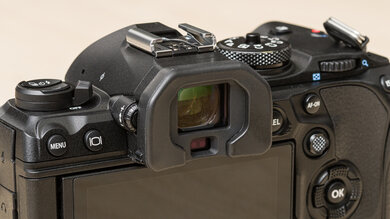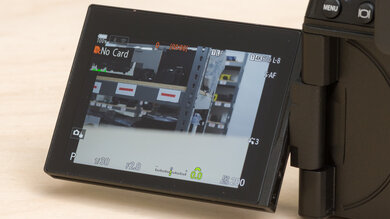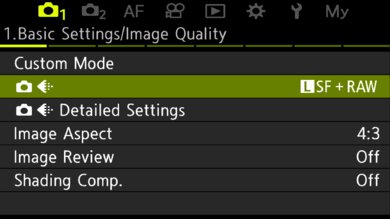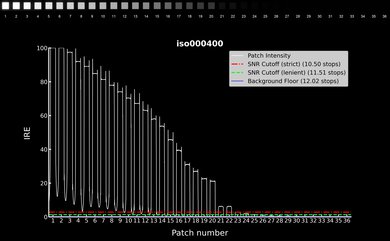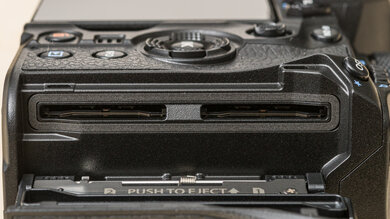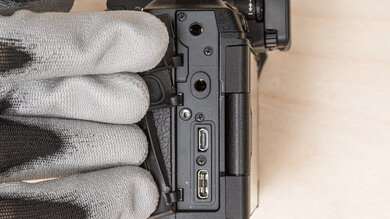The OM SYSTEM OM-1 Mark II is an updated version of the flagship OM SYSTEM OM-1. Though it finally bears the OM SYSTEM name—physically as well as in spirit—the Mark II follows closely in the same footsteps as its predecessor, with a few notable upgrades. That includes some added processing power, thanks to more onboard RAM for its sensor, a new graduated digital ND filter, along with other improvements in how features are implemented—all in a ruggedly built but relatively portable body that's ideal for outdoor photography in all kinds of shooting conditions.
Our Verdict
The OM SYSTEM OM-1 Mark II is very good for travel photography. It's a very well-built and relatively compact camera. It isn't the most portable option for travel by any means, but it's a great choice for more intrepid travelers who have their sights set on destinations with more adverse weather conditions, thanks to extensive weather-sealing and a sturdy build. In addition, you'll find plenty of compact lens options within the MFT ecosystem. Battery life is also excellent, and though the camera's complex controls and customization options are overkill for travelers who simply want to point and shoot, the camera's ergonomics are well-tailored to more advanced shooters who want more control over their shooting experience. That said, the camera's autofocus system is good for most situations, but it isn't the most reliable in busier settings.
- Excellent build quality, with an IP53-rating against dust, moisture, and cold.
- Relatively portable, albeit on the heavier side.
- Wide range of relatively compact lens options.
- Excellent battery life.
- Autofocus tracking isn't always reliable.
The OM SYSTEM OM-1 Mark II is good for landscape photography, especially if you tend to shoot in very remote locations and need something more rugged. It's very well-built, with extensive weather-sealing, a high-res EVF, and great ergonomics. Its sensor also performs well for its class, with good dynamic range and a relatively high resolution, though it doesn't have the best noise handling in low light. Thankfully, it has some neat computational features that help with various kinds of landscape photography, including a high-res shot mode that captures 14-bit RAW files of either 50 megapixels handheld or 80 megapixels with a tripod.
- Excellent build quality, with an IP53-rating against dust, moisture, and cold.
- Relatively portable, albeit on the heavier side.
- Wide range of relatively compact lens options.
- Excellent battery life.
- Good RAW dynamic range.
- High-Res Shot mode for 14-bit composite RAW images with up to 80MP resolution.
- Noise handling is just okay.
The OM SYSTEM OM-1 Mark II is good for sports and wildlife photography. It can shoot at remarkably fast burst rates in its electronic shutter mode, and the stacked design of its sensor keeps rolling shutter effect to a minimum, though artifacts are still possible with very fast-moving subjects. In addition, it has a pre-burst 'Pro Capture' mode that starts recording frames in anticipation of a subject's movement, then saves a pre-set amount after you fully press the shutter, which is especially handy for wildlife photography. It comes with plenty of subject detection modes aided by machine learning algorithms; in practice, its autofocus tracking isn't the most reliable, but it still performs fairly well overall. On top of that, the camera is very well-built, with good ergonomics and plenty of customization options. Finally, MFT lenses are typically more compact, allowing you to pack longer lenses without as much bulk as other systems. That said, if you manage to fill up the photo buffer, it takes a long time for it to empty, which can slow you down at a critical moment.
- Excellent build quality, with an IP53-rating against dust, moisture, and cold.
- Wide range of relatively compact lens options.
- E-shutter burst shooting at up to 120 fps with AF-S and 50 fps with AF-C.
- Wide range of subject detection modes.
- 'Pro Capture' pre-burst mode.
- Autofocus tracking isn't always reliable.
- Buffer takes a long time to empty.
The OM SYSTEM OM-1 Mark II is good for vlogging, though this isn't its main intended use. It has a fully articulated screen, so you can easily monitor yourself while recording, but it's a fairly heavy and more ruggedly built camera, so it isn't the most portable for walk-and-talk vlogs. Thankfully, it has a wide range of frame rate options, including 4k at up to 60 fps without a crop and slow-motion recording in 1080p at up to 240 fps. That said, it's a bit more limited for more advanced shooters, with 10-bit H.265 capture reserved for its more finicky OM-Log format.
- Excellent build quality, with an IP53-rating against dust, moisture, and cold.
- Excellent battery life.
- Not the most portable option for on-the-go recording.
The OM SYSTEM OM-1 Mark II is good for studio video work, but this isn't its main intended use. It has great external video output, with support for 12-bit 4:4:4 ProRes RAW when paired with a compatible Atomos recorder. However, its internal capabilities are a bit more limited, with 10-bit H.265 recording only available when using OM-Log or HLG and 4:2:0 chroma sampling. On the upside, it doesn't struggle with overheating, and it has a fantastic battery life.
- Excellent build quality, with an IP53-rating against dust, moisture, and cold.
- Excellent external recording capabilities.
- Supports 10-bit internally.
- Excellent battery life.
- Limited to 4:2:0 internally.
- Recording formats and resolution options are more limited than leading video cameras.
The OM SYSTEM OM-1 II isn't meant for POV-style action video but is great for recording action from the sidelines. It's a relatively heavy, bulky camera for action video, but it's very well-built, with extensive weather-sealing against dust, moisture, and snow. It also offers a good range of frame rate options, including 4k at up to 60 fps and 1080p slow-motion at up to 240 fps.
- Excellent build quality, with an IP53-rating against dust, moisture, and cold.
- Not the most portable option for on-the-go recording.
The OM SYSTEM OM-1 Mark II captures good RAW image quality. It has good dynamic range overall, with the option to capture 14-bit RAW files in its High-Res Shot mode for a bit of added dynamic range. Its sensor has a relatively high resolution, so images appear sharp with a good level of fine detail. However, its noise management in low light is just okay.
- Good RAW dynamic range.
- Noise handling is just okay.
Performance Usages
Changelog
-
Updated Mar 25, 2025:
We wrote text for the new tests added in Test Bench 0.13.
- Updated Feb 11, 2025: We've converted this review to Test Bench 0.13. We've added new tests for Video Dynamic Range and Luminosity Patch Detection. You can learn more about these updates in the changelog.
- Updated May 01, 2024: Review published.
- Updated Apr 24, 2024: Early access published.
Check Price
Differences Between Sizes And Variants
The OM SYSTEM OM-1 Mark II comes in one color: Black. You can buy the camera body alone or bundled with a kit lens like the OM SYSTEM M.Zuiko Digital ED 12-40mm f/2.8 PRO II.
You can see our unit's label here.
Popular Camera Comparisons
The OM SYSTEM OM-1 Mark II builds on the foundation created by the flagship OM SYSTEM OM-1 to become one of the most full-featured Micro Four Thirds cameras on the market, with a dizzying array of computational photography modes. While it doesn't revolutionize the formula, it offers some upgrades, from small touches like rubberized dials to notable improvements in the camera's autofocus system, buffer depth, IBIS, and computational features like Live ND. It probably isn't worth buying if you already own an OM-1, but there are enough meaningful improvements to make the Mark II an attractive prospect for Micro Four Thirds shooters, especially those of the birding or wildlife photography persuasion. That said, it's a bit behind the times for video, with a price tag that may be hard to justify for some.
For more options, check out our recommendations for the best cameras for wildlife photography or the best cameras for bird photography specifically, the best travel cameras, or the best cameras we've tested overall.
The Panasonic LUMIX G9 II and the OM SYSTEM OM-1 Mark II are both excellent flagship Micro Four Thirds cameras. The LUMIX offers a bit more value for its price, especially for hybrid shooters, with better video features than the OM-1 Mark II. That said, the OM-1 Mark II has a few advantages for wildlife photography, with a more portable body, more robust weather-sealing, and a stacked sensor that allows for faster burst speeds and less rolling shutter distortion.
The OM SYSTEM OM-1 Mark II is an updated version of the OM SYSTEM OM-1. Physically, the cameras are nearly identical, though the OM-1 Mark II does add rubberized control dials that offer a bit more grip, as well as having more onboard RAM in its sensor, allowing for faster processing and a larger buffer depth. A few other notable improvements include a more robust Live ND feature, with new graduated ND filters and improved autofocus and IBIS implementation. Those looking to upgrade from an older model will benefit from going with the OM-1 Mark II, but if you're on a tighter budget, you won't be disappointed by opting for the OM-1. The cameras are also similar enough that it isn't worth the upgrade if you own an OM-1.
The OM SYSTEM OM-1 Mark II is better overall than the Olympus OM-D E-M1 Mark III. While the Olympus model has slightly better ergonomics, the OM SYSTEM has a higher-resolution EVF and screen, along with a more efficient stacked sensor that allows for quicker electronic burst shooting with less rolling shutter distortion. It also has a more reliable autofocus system and better video features.
The Sony α7 IV is more well-rounded than the OM SYSTEM OM-1 Mark II, with better internal video recording capabilities and a more effective overall autofocus system. That said, the OM SYSTEM is more portable, including the option to use more compact Micro Four Thirds lenses, and has better weather-sealing, making it a better fit for outdoor and wildlife photography.
Test Results

The OM SYSTEM OM-1 Mark II is relatively portable compared to most full-frame cameras despite being on the heavier and bulkier side for a Micro Four Thirds model. But given its more rugged exterior, it isn't bad. That also means it won't feel too imbalanced when paired with larger telephoto lenses.
The OM SYSTEM OM-1 Mark II has excellent build quality. Like its predecessor, it's thoroughly weather-sealed, with an IP53 rating that protects it against dust and spraying water. The manufacturer also advertises that the camera is freezeproof down to -10°C (14°F). That means you don't have to worry too much about shooting in rainy or snowy conditions.
The body itself feels well-built and is made of magnesium alloy. All of the ports and inputs are sealed and covered securely, with locking hinged doors for the battery compartment on the bottom and the SD card compartment on the side. The buttons and the joystick are made of plastic, so they feel a bit slippery, though both the D-pad and joystick are textured. The buttons, including the shutter button, also feel a bit mushy to press. The biggest difference in build quality and design from the OM SYSTEM OM-1 is that the control dials are now rubberized rather than made of hard plastic, which offers a little more grip and control, especially if you're shooting in wetter conditions or wearing gloves.
The camera has excellent ergonomics. It handles almost identically to the OM SYSTEM OM-1, with a large, comfortable hand grip and thumb rest. The grip around the camera is well-textured and provides a secure hold. The buttons are well-placed for the most part, though some design choices, like having the menu button on the left side and having it double as the back button, make it a bit harder to navigate through settings since the menu isn't navigable through the touchscreen. Those with smaller hands might also have difficulty reaching all of the buttons without adjusting their grip. Overall, the ergonomics are great, but the camera has its quirks.
The OM-1 Mark II has a large fully-articulated screen. The screen mechanism feels very solid, and the high resolution makes it easy to review your images with relative accuracy and clarity. That said, its touch functionality is somewhat limited; you can't use the screen to navigate through the main settings menu, for instance. It can, however, be used to select options in the quick menu and adjust your exposure settings, though other settings can only be adjusted by turning the dials. You can also use the touchscreen to select focus points or as a touch shutter.
The menu system is the same one found on the OM SYSTEM OM-1, which represents a step up from older Olympus menus. The tabs are more clearly organized, with better naming and a fairly intuitive layout. There are a lot of settings and customization options, but it doesn't feel overwhelming or confusing. There's also a useful help function, which explains certain settings when you press the 'Info' button. Plus, there's always the quick menu, which gives you access to frequently used settings.
That said, one quirk we encountered is that the monitor doesn't indicate when the camera is set to slow or fast motion, as you can see here.
The OM SYSTEM OM-1 Mark II uses a 20.4 MP Micro Four Thirds sensor. While it uses the same TruePic X processor as the OM SYSTEM OM-1, OM SYSTEM also advertises that they've increased the on-board memory, allowing for improvements like a larger image buffer.
While the OM-1 includes a digital 'Live ND' neutral density filter mode, the Mark II improves upon it with an additional EV stop, allowing you to set it up to ND128 (7 stops). On top of that, there's a new 'Live GND' mode, which simulates a graduated ND filter with three settings: ND2, ND4, and ND8 (1-3 stops). You can set it to have a soft, medium, or hard gradient, set the midpoint, and rotate your gradient. This is super useful if you want to even out the exposure for a landscape with a bright sky and a darker foreground. You can see an example of the 'Live GND' filter, set to ND8 with a soft gradient here, compared to a standard image of the same scene here.
Like the OM-1, the camera also includes a 'High-Res Shot' mode, which uses the IBIS system to capture multiple frames while shifting the pixels incrementally, then combines them into one higher-resolution image. However, it now captures these files in 14-bit RAW, as opposed to 12-bit, offering the capacity for greater dynamic range. There's a 'Handheld' setting that captures images of up to 50 MP (sample image here) and a 'Tripod' setting that captures images of up to 80 MP (sample image here) but requires a tripod.
The camera's overall battery performance is fantastic. It's CIPA-rated for 520 shots on a full charge, which is excellent for a mirrorless model. In its 'Quick Sleep' energy-saving mode, it has a CIPA rating of 1100 shots. Of course, CIPA ratings don't necessarily reflect real-world usage, so your battery life will vary depending on how you use your camera.
The camera is remarkably efficient in video mode, lasting over three hours of continuous 4k video recording. If you need to extend the battery life even further, it also supports external power delivery via USB-C. Note that to enable power delivery, you have to actually select the option in a pop-up menu that appears when the camera is connected to an external power supply.
The OM SYSTEM OM-1 Mark II has a wide range of continuous shooting options. It shoots at a respectably fast max mechanical burst rate, but where it really shines, enabled by its stacked sensor, is in its electronic burst mode. At the max 120 fps, you're locked into AF-S, so that setting is less suitable for tracking subjects moving towards or away from you, but it works well if you need to capture a brief but comprehensive burst of a particular, fleeting moment, like a bird feeding its young. There are also 25 fps and 50 fps options, which allow for AF-C with subject tracking, depending on the lens. That being said, though the stacked sensor allows for a faster readout speed, there's still a chance of encountering rolling shutter artifacts when using the electronic shutter.
As for the buffer, OM SYSTEM advertises that the buffer size has doubled from the OM SYSTEM OM-1 and that largely tracks with our testing. We couldn't fill the buffer after 30 seconds of continuous shooting using the mechanical shutter at 10 fps. However, the buffer did fill up at the 31s mark after shooting 293 RAW frames, so in most situations, you won't ever have to worry about filling it. If you shoot in JPEG, you're unlikely to fill up the buffer within a reasonable timeframe, if at all.
Like its predecessors, the OM-1 Mark II also has a 'Pro Capture' mode that begins burst shooting with a half-press of the shutter but only saves the burst, going back a pre-set number of frames, once you press all the way. This ensures you won't miss a critical moment and is especially handy for wildlife and bird photographers, who often have to wait for the moment of action, like when a bird takes off in flight. The added buffer size comes in handy here, giving you some more leeway to record more frames in anticipation of your subject's movement.
Unfortunately, all that continuous shooting power comes with a downside, and that's how long it takes to empty the buffer once it is full. To go from burst shooting into video mode, the camera takes almost a minute and a half to fully empty the buffer.
The camera improves upon the autofocus system from the OM SYSTEM OM-1. It's the same hybrid AF system with AI-driven subject detection, but the implementation has been improved. Human detection is now included in the system's AI detection algorithms, in addition to a plethora of other subjects, from birds, cats, and dogs to trains, planes, and automobiles, with subjects as specific as steam locomotives and bullet trains.
When it comes to tracking moving faces, however, the camera performs similarly to its predecessor. Overall, it does an okay job with faster subjects in busy settings, but it won't nail focus completely, especially when subjects move more erratically.
If you stick to a center focus point rather than relying on subject tracking, the camera is very consistent and reliable. With over 1,000 AF points, it offers very precise focusing, and as long as you keep your subject under the focus point, it won't have trouble keeping them in focus.
The OM SYSTEM OM-1 Mark II has an exceptional in-body image stabilization system. Improving upon its predecessor, it's advertised to offer up to 8.5 stops of compensation. You can fine-tune the stabilization with settings that limit it to specific axes. 'IS1' applies image stabilization to all axes, 'IS2' limits it to the vertical axis for horizontal panning, and 'IS3' limits it to the horizontal axis for vertical panning. There's also an 'IS Auto' mode that can detect when the camera is panning and suspend stabilization on that particular axis. In addition, there's a 'Handheld Assist' function that, when you half-press the shutter button, indicates if there's camera shake and uses frame lines to show to what extent the image can be stabilized.
Overall, the camera does an exceptional job of image stabilization, letting you capture clear handheld shots at incredibly slow shutter speeds. We tested stabilization using the Olympus M.Zuiko ED 12-40mm f2.8 PRO, which doesn't include optical stabilization. That said, stabilization performance can vary depending on your lens, the focal length you shoot at, and even how steady your hands are.
The OM SYSTEM OM-1 Mark II has good usable dynamic range, particularly at its base ISO. At higher ISOs in low light conditions, the range of detail the camera can capture drops off. Still, it does a good job for a Micro Four Thirds sensor.
Images look quite sharp thanks to the relatively high resolution of the camera's sensor. You have a bit of leeway to crop in your images. You can also take advantage of the camera's High Res Shot mode to get composite images with a greater level of fine detail.
The camera's RAW noise handling is okay. Noise becomes quite apparent in darker conditions, but it performs on par with other Micro Four Thirds sensors, and you can always mitigate some noise by increasing the exposure. You'll just have a harder time getting around it in trickier shooting conditions.
The OM SYSTEM OM-1 Mark II niche is first and foremost wildlife photography, but for a photography-first camera, it's fairly full-featured for video work. That said, there's nothing really new here compared to the original OM SYSTEM OM-1.
The camera can record 1080p and 4k/C4k video, though it now adds a 9:16 vertical recording option for social media content creators. It can output 12-bit ProRes RAW video to a compatible Atomos recorder with full 4:4:4 chroma sampling, giving creators greater flexibility for keying and VFX work if they need it.
Most of the camera's video profiles are limited to 8-bit H.264 video, including its Flat profile. Meanwhile, 10-bit H.265 video is only supported when using the camera's OM-Log400 or HLG profiles. Additionally, All-I compression is only available when recording in FHD.
The OM SYSTEM OM-1 Mark II has a great range of frame rate options in 4k. While it can't record at 120 fps, it supports 4k recording at up to 60 fps without a crop, which is great.
The camera's internal recording capability is good overall, but it's still slightly behind the times. While it does support 10-bit recording, it's also limited to 4:2:0 sampling internally, and 10-bit is only available when using HLG or OM-Log400, which can be finicky to color-grade. Still, there are no arbitrary recording time limits, which is nice, and the camera has no issues with overheating.
The camera's AF works well in video. It has many subject detection modes, including animals, vehicles, and now humans, including more precise eye detection. Overall, it does a great job with moving human subjects despite not being the snappiest or most consistent. Depending on your settings, the autofocus can also be somewhat choppy. You can smooth it out by adjusting the AF speed at the expense of slower focus transitions.
The OM SYSTEM OM-1 Mark II captures great overall video quality. It does an excellent job in more controlled lighting conditions, with crisp video and nice colors straight out of the camera. It's also impressive in low light, without too much noise, and with good detail preservation.
Thanks to its stacked sensor, the OM SYSTEM OM-1 Mark II has a quick readout speed, resulting in very minimal rolling shutter distortion.
The camera has a wide range of frame rate options in 1080p, at up to 240 fps, with a dedicated slow/fast motion mode.
The same internal recording limitations apply in 1080p as in 4k. While there's no recording time limit, and the camera supports 10-bit recording in its Log and HLG modes, it's limited to 4:2:0 sampling.
As with 4k, the AF does a good job tracking moving subjects. It isn't the quickest or most accurate AF on the market, but it's quite reliably overall, and the wide range of subject detection modes are very useful. You can also fine-tune how the AF performs by tweaking your settings.
As with 4k, rolling shutter distortion is very minimal when panning in FHD.
The camera has great video dynamic range when shooting in OM-Log400. While the usable dynamic range is excellent, there's less total dynamic range above the background floor than some full-frame options like the Panasonic LUMIX S5 II, for example. There's also less headroom in the highlights, so overall, you'll have less flexibility to make exposure adjustments in post, but the camera's capable of capturing a fairly wide range of detail overall.
Tested settings:
- Resolution: 4k
- Frame Rate: 30 fps
- Log Format: OM-Log400
The OM SYSTEM OM-1 Mark II has two SD card slots, both rated for UHS-II cards, which is great for those who like to keep a running backup or separate RAW and JPEG files. They're well-placed on the side of the camera, so it's easy to switch out cards when using a tripod.
The OM SYSTEM OM-1 Mark II has a USB-C port for charging, file transfer, and external power delivery. There's also a Micro HDMI port to connect to an external recorder or display, as well as mic and headphone jacks.






